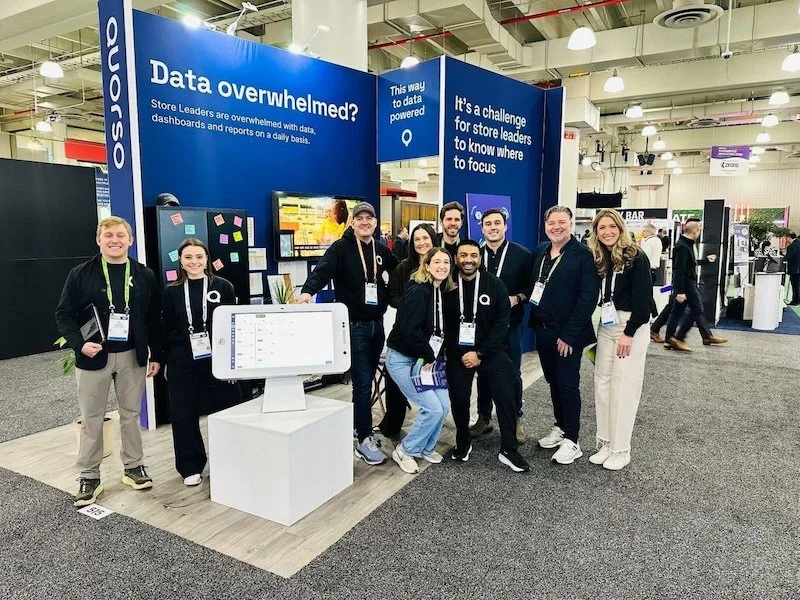Srinivas Rao Burri engineers trust in digital commerce: talking AI, risk, and the future of payments
By Ellen F. Warren.
Srinivas Rao Burri, Director of Software Engineering at Western Union, leads transformative initiatives at the intersection of risk and compliance, cloud innovation, and AI driven systems.
With more than 20 years of experience spanning banking, financial services, and media, he has authored multiple IEEE and Springer papers exploring how emerging technologies can improve trust, efficiency, and intelligence across digital ecosystems.
Srini earned an M.S. degree in Software Development from Boston University. His ongoing professional development includes advanced certifications in Machine Learning from Stanford University, Data Science - Machine Learning from Harvard University, and Data Scientist from John Hopkins University.
In this Q&A with RTIH, he shares his perspective on how advanced AI and automation are reshaping retail and payments innovation - and what it takes to engineer compliance, resilience, and customer confidence in the digital era.
RTIH: Srini, your current role with a multinational financial services company sits at the crossroads of retail, payments, and compliance. How do you see technology driving trust and transparency in today’s digital transaction landscape?
SB: Using new technology like blockchain and artificial intelligence (AI), we're making digital payments much safer, faster and more reliable. Blockchain and similar tech work is like a super secure digital notebook, so once a transaction is recorded, it's impossible to change. Meanwhile, AI acts as a smart fraud detector, watching payments in real-time to catch anything suspicious right away, which makes people more confident when they pay.
To keep Customer personal info safe, systems use things like tokenization (which scrambles customer card numbers) and multi-factor authentication (which asks for more than one way to prove it's you). We also use technology to automatically follow all the rules and regulations, like PCI DSS, so everything is up to code.
Another exciting technology is "Explainable AI," which helps us understand why a computer made a certain decision, making the process more transparent.
Finally, Big Data technology helps a lot by looking at huge amounts of information to make the whole payment experience better, more personal, and centred around what customers need.
RTIH: You have led initiatives in risk and compliance engineering for global payment systems. What innovations or frameworks are most critical to ensuring compliance without slowing down the customer experience?
SB: Finding the right balance between compliance and customer experience is indeed achievable when organisations implement effective strategies combined with the right technology solutions. This balance is not accidental but the result of deliberate efforts to align various teams, tech stack and processes.
A key factor to this success is breaking down silos that traditionally exist among engineering, compliance, and operations teams. By fostering collaboration and creating a cohesive mission, these teams can work together with a shared focus on delivering a smooth and seamless customer journey.
Involving experts from diverse areas such as compliance, legal, customer service, and user experience design during the development of new processes is critical. Their combined insights ensure that solutions meet stringent regulatory requirements while aligning with - and exceeding - customer expectations.
Furthermore, leveraging advanced data analytics and AI technologies can help organisations identify potential compliance issues discreetly and proactively. At the same time, implementing user-friendly security features enhances the overall customer experience by making compliance feel less intrusive and more intuitive.
By thoughtfully integrating regulatory checks directly into the customer journey and digitising key processes, companies are able to streamline interactions significantly. This approach allows them to maintain strict compliance standards without compromising user satisfaction or creating friction during customer interactions.
Srinivas Rao Burri: “AI will predict customer behaviour, enabling personalised offers at the right time, new payment methods like facial recognition, and smarter cart abandonment prevention”
RTIH: Retailers and payment providers face increasing regulatory scrutiny. How can AI and automation help organisations proactively manage compliance and mitigate fraud in real time?
SB: AI and automation are fundamentally shifting fraud mitigation from a reactive to a proactive strategy by analysing massive, real-time datasets to detect subtle anomalies and catch complex scams like synthetic identity fraud before financial loss occurs. These advanced technologies enable organizations to identify fraudulent activities much earlier than traditional methods, thereby preventing significant damage and reducing risk exposure.
Furthermore, these technologies also transform regulatory compliance into a continuous, agile operation by constantly monitoring legal databases and automating tasks such as customer onboarding and transaction monitoring. This ongoing vigilance allows businesses to stay up-to-date with evolving regulations and ensures that compliance processes are both efficient and effective, minimising the chances of violations and penalties.
While enhancing operational efficiency and improving the overall customer experience, implementing these technologies require careful ethical oversight and governance to address potential issues such as algorithmic bias. Organisations must establish robust frameworks to ensure transparency, fairness, and accountability in AI driven decision-making processes, thereby maintaining trust and safeguarding against unintended consequences.
RTIH: In your research, you’ve explored AI enabled routing optimization and predictive analytics. How do you envision these capabilities influencing the future of retail payments and checkout experiences?
SB: AI enabled routing optimisation and predictive analytics are poised to transform retail payments and checkout processes by enabling seamless, personalised transactions while simultaneously enhancing fraud prevention and operational efficiency.
AI can help to transform retail payments by using machine learning to process payments faster and cheaper, benefiting everyone. Smart payment systems use machine learning to find the best transaction routes, making payments faster, cheaper, and more reliable. AI will predict customer behaviour, enabling personalised offers at the right time, new payment methods like facial recognition, and smarter cart abandonment prevention.
Retailers will gain improved fraud detection, efficient supply chains, and faster customer support. This technology continuously learns to speed up and secure transactions, anticipates interest, and sends relevant offers. For retailers, it revolutionises fraud detection and product delivery with maximum efficiency.
RTIH: Generative AI and deep learning models are advancing rapidly. From your work on spectral normalization in generative adversarial networks (GANs), what lessons can the retail tech community take away about ensuring stability and ethical AI performance?
SB: Lessons from spectral normalisation in Generative Adversarial Networks (GANs) provide a valuable framework for ensuring both stability and ethical performance of AI systems in the retail sector. This technique improves GAN stability by effectively managing the complexity of the model, which helps prevent erratic behaviour during training.
Such an approach can be adapted and applied to retail AI systems to achieve consistent and reliable performance over time. For example, it can help prevent issues like "model collapse" in recommendation engines, where the system might otherwise produce repetitive or unhelpful suggestions.
Moreover, spectral normalisation contributes to enhancing security measures against fraudulent activities by maintaining robust model behavior under various conditions. In addition to these technical benefits, there are important ethical considerations that must be addressed for responsible deployment of AI in retail.
These include actively mitigating algorithmic bias to ensure fairness across diverse customer groups, ensuring that AI decisions are explainable and transparent to stakeholders, and rigorously maintaining data privacy to protect sensitive consumer information.
By adopting these principles inspired by spectral normalisation and ethical best practices, retailers can foster stronger consumer trust and ensure compliance with regulatory standards. This approach also helps safeguard intellectual property and maintain brand integrity in an increasingly competitive and technology driven marketplace. Overall, integrating these lessons into retail AI strategies supports both technological robustness and responsible innovation.
RTIH: As digital payments evolve, interoperability across systems and geographies remains a challenge. What strategies or technologies do you believe can help create seamless, compliant global payment networks?
SB: Yes, the payment industry increasingly handles cross-border transactions worldwide. Technology should support advanced frameworks to build a global network for seamless transactions. To build smooth, fast, and secure global payment systems, we need to focus on three key areas: smart technology, strict adherence to regulatory rules, and effective collaboration among all stakeholders.
By leveraging advanced technologies like blockchain, we can create transaction records that are exceptionally secure and tamper-proof. Additionally, implementing real-time payments enables us to make payments happen instantly, improving the overall user experience. All of this is made possible by using APIs, which allow different systems to connect and communicate seamlessly with one another.
To maintain safety and security, we employ AI and machine learning (ML) techniques to detect and prevent fraud as it occurs in real time. Looking ahead, the introduction of Central Bank Digital Currencies (CBDCs) holds the potential to simplify and accelerate the movement of money across borders even further, making international transactions more efficient and accessible.
The key to success lies in ensuring that all these diverse systems can communicate effectively with each other and that all parties involved are aligned and compliant with the relevant regulations. By achieving this level of interoperability and regulatory harmony, and by migrating all operations to the cloud, we can build a modern payment system that is reliable and efficient, and delivers an excellent experience for customers worldwide.
RTIH: Risk and compliance engineering is often seen as a “back-end” discipline, but it’s becoming a differentiator for customer trust. How can retail technology leaders elevate its role within their organisations?
SB: Keeping up with risk and compliance rules is crucial in the world of digital payments. As banks and FinTech companies grow, so does the risk of financial crimes like money laundering and fraud. To fight this, companies need strong AML (anti-money laundering) compliance controls, which should be built directly into product designs from the very beginning. This helps promote a proactive approach to compliance, ensuring all regulations are met.
The convenience of digital payments also creates risks. Money laundering involves making illegally earned money look legitimate, while fraud uses deception for financial gain. Both can damage a company's reputation and lead to serious penalties. Digital payments make AML compliance challenging because transactions are fast, and criminals are constantly changing their tactics.
AML programmes help companies prevent and stop these crimes through three main steps:
Customer Risk Assessment: This involves checking a customer's risk level based on things like their location and history, and it needs to be updated regularly.
Know Your Customer/Business (KYC/KYB): This process verifies the identity of customers and companies to prevent illegal activity.
Transaction Monitoring: Automated systems continuously monitor transactions in real-time to flag any unusual or high risk activity.
FinTechs and online banks, in particular, face higher AML risks due to their digital nature. To manage this, they need to modernise the digital platforms that can handle real-time monitoring, risk assessments, KYC/KYB checks, and reporting.
RTIH: Beyond payments, your publications touch on machine learning applications in sectors like agriculture and healthcare. What cross-industry innovations do you think could translate effectively into retail and commerce?
SB: Using smart technology from other fields such as farming and medicine can really help the retail and commerce world in many impactful ways.
For example, just as farmers use advanced ML techniques to get the most out of their crops, by analysing various factors such as weather patterns and soil conditions, retailers can apply the same kind of sophisticated technology to better manage their inventory. They can also predict what products customers are likely to buy and dynamically adjust prices in real time based on current market trends and consumer behaviour.
From the healthcare side, where the focus is on analysing a single person's detailed data, retailers can learn how to offer much more personalised shopping experiences to their customers. They can also predict when a customer might stop buying from them, enabling proactive retention strategies, and even enhance security measures to keep fraud and theft in check effectively.
Adopting and adapting these innovative ideas from other industries will enable businesses in the retail sector to operate more efficiently, save significant costs through automation, and make smarter, faster decisions. This is all possible because they gain a much deeper understanding of their customers and the overall market dynamics.
RTIH: You’ve guided teams through large scale cloud and digital transformations. What leadership lessons stand out from your experiences driving that change across complex, regulated environments?
SB: While leading this critical transformation, I learned that being "digital" is a state of mind, not just a set of tools. Focus on embedding a culture of experimentation, adaptability, and continuous learning into the organisation's mindset, culture, and processes. This creates an organisation that can embrace constant change.
Large scale cloud and digital transformations in heavily regulated FinTech and banking environments reveal critical leadership lessons. The journey highlights that success hinges on a human centric, empathetic, and strategically aligned approach, rather than focusing solely on technology.
Transformation is about people, not just technology. I also learned that the human and cultural side of change is the hardest part. Successful transformations prioritise upskilling employees, fostering a collaborative mindset, and creating psychological safety so teams can adapt and innovate.
Large financial institutions are often fragmented. To run the programme successfully, as a leader, we should create an "integration layer" that connects workstreams and fosters cross-functional collaboration between IT, operations, finance, and compliance.
This ensures all teams are aligned on a shared strategic roadmap, preventing disjointed initiatives. Furthermore, legacy processes and risk averse cultures can also slow change. As a leader, I should identify key influencers across the organisation and engage them directly, turning potential blockers into advocates for the transformation.
Another key factor for the success of transformation is that cloud and digital initiatives should not be framed merely as cost-cutting measures. Leaders must tie investments to measurable key performance indicators (KPIs) that demonstrate business value, such as improved customer experience, faster time-to-market, and enhanced security and reliability.
In regulated industries, security is non-negotiable. Successful leaders build compliance and security into the DNA of the transformation from the very beginning. This includes robust governance frameworks, automated security controls, and transparent reporting to satisfy regulatory scrutiny without sacrificing agility.
Lastly, modernise, don't just "lift and shift." Instead of building new technology to fit old, legacy processes, leaders should use the transformation as an opportunity to modernise and optimise. Building new processes that maximise value from the new technology is crucial. For financial services, this means moving beyond simple "lift and shift" to re-architecting systems for cloud native capabilities.
RTIH: What emerging technologies - AI, quantum computing, decentralised identity - do you see having the greatest impact on secure, intelligent, and frictionless retail ecosystems over the next five years?
SB: I believe each of these emerging technologies will help retail ecosystems build core capabilities like user experience, compliance, and data management.
AI is set to reshape retail within the next five years, making shopping experiences more personal for customers by tailoring recommendations and marketing based on individual tastes. This technology will also boost retailers' efficiency, automating tasks and optimising supply chains, which saves money and speeds up service. Additionally, AI will improve security by detecting and preventing fraud in real-time, helping to keep customer transactions safe.
Meanwhile, decentralised identity (DID) will be key to building trust. Instead of companies holding all Customer personal data in one place, DID lets customers control their own digital identity. This reduces the risk of massive data breaches and streamlines the checkout process. Customers could, for example, prove age requirements like “customer over 21” without revealing the customer’s exact birth date.
Quantum computing (QC) is a bigger, longer-term development. While its full potential is still in the distance, it could supercharge AI and solve problems that are currently too complex for our computers. However, its immense power means it could also break today's cybersecurity protections. Because of this, companies need to start preparing now by developing "quantum resistant" security measures to protect customer data from future quantum threats.
Under the umbrella of innovation, these technologies will revolutionise retail and payments over the next five years.
RTIH: Finally, for retail technology innovators seeking to balance speed, compliance, and customer trust - what guiding principles or mindset do you believe will define success in the next era of digital transformation?
SB: Retail innovators who want to succeed in the future need to think differently about how they handle speed, rules, and customer trust. The traditional view of security and compliance as a dull, back-end task that simply blocks new ideas is now outdated and no longer serves modern business needs effectively.
Instead, the new approach is to see these elements as a core part of the customer experience that actively builds and reinforces trust between the business and its customers.
This new mindset emphasises three key shifts for businesses to adopt. First, a trust-first approach requires leaders to prioritise customer trust in every aspect of their operations, making it an integral part of their organizational culture and decision-making processes.
Second, adopting a DevSecOps mindset enables companies to seamlessly incorporate compliance and security checks into their development workflows, transforming what used to be seen as obstacles into opportunities for creating stronger, more reliable products.
Third, leveraging advanced technologies such as AI, decentralised identity, and regulatory tech allows businesses to implement automated security measures that operate smoothly behind the scenes, providing customers with a frictionless experience while ensuring robust and reliable protection.
Ultimately, the goal is to shift from a reactive, "check-the-box" approach to compliance and security towards a continuous, data driven culture of responsible innovation. This approach ensures that a company can remain agile and innovative in a fast changing market while simultaneously protecting its customers and adhering to regulatory requirements.
In doing so, businesses build lasting trust with their customers, which is essential for long-term success and competitive advantage.

































Continue reading…